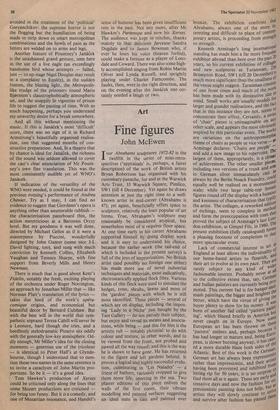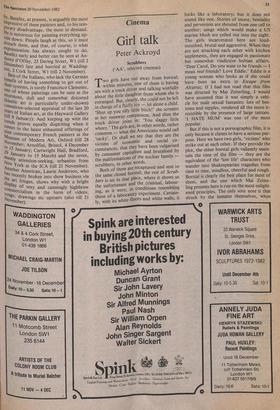Art
Fine figures
John McEwen
Ivor Abrahams sculptures 1972-82 is the twelfth in the series of mini-retro- spectives ('appraisals' is, perhaps, a fairer description) of the work of British artists Bryan Robertson has organised with his customary panache, for and at the Warwick Arts Trust, 33 Warwick Square, Pimlico, SW1 (till 4 December). Yet again he draws attention at just the right time to a well- known artist in mid-career (Abrahams is 47); yet again, beneficially offers space to sculpture, relatively the least popular of art forms. True, Abrahams's sculpture may reasonably be considered atypical, but nonetheless most of it requires floor space. At one time early in his career Abrahams supported himself by doing display work and it is easy to understand his choice, because the earlier work (the tail-end of which is included in the present survey) is full of the joys of improvisation. No British artist (and possibly no foreign one either) has made more use of novel industrial techniques and materials, most indicatively, electrostatically applied flock fibre. Various kinds of this flock were used to simulate the hedges, trees, shrubs, lawns and moss of the 'garden' pieces with which he is still most identified. These pieces — several of which are on display, including the impos- ing 'Lady in a Niche' just bought by the Tate Gallery — do not parody their subject, but enjoy and reveal its means and associa- tions, while being — and this for him is the artistic rub — notably pictorial: to do with colour and texture, in other words, and to be viewed from the front, not probed and pawed all the way round; and this is the way he is shown to have gone. He has returned to the figure and left gardens behind. It proves a logical and highly successful evolu- tion, culminating in 'Les Naiades' — a frieze of bathers, variously cropped to give them more life, sporting in the sea. Two plaster editions of this piece enliven the walls of the first room, their vibrant modelling and painted surfaces suggesting an ideal state in cast and painted over The Spectator 20 November 1982 bronze. The exhibition confirms that Abrahams, always one of the more in- teresting and difficult to place of contem- porary artists, is proceeding from strength to strength. Kenneth Armitage's long international standing has made him a far more frequent exhibitor abroad than here over the past 20 years, so his current exhibition of collages and new sculptures at Taranman, 236 Brompton Road, SW1 (till 20 December) is much more significant than the smallness of the venue might suggest. Taranman consists of one front room and much of the work has been made with its diminutive size to mind. Small works are usually models for larger and grander realisations, and the fact that in this instance they are not, seems to concentrate their effect. Certainly, a series of 'chair' pieces is unimaginable on anY other scale, and appears the most obviously inspired by this particular event. The works are variations on the anthropomorphic theme of chairs as people or vice versa — as Armitage declares: 'Chairs are people:- c and add a new image to his repertoire. In largest of them, appropriately, is a cliallvc of achievement. The other smaller pieces' including two versions of a trunk and arm in German silver immaculately cast asd always by the Berlin Noack Foundry, coal I equally well be realised on a monuments scale; while two large table-top fernate figures round off the display with a hunloa' 'and keenness of characterisation that typify the artist. The collages, a reworked editioa of etchings, seem to complete in method and form the preoccupation with trees that proved the subject of Armitage's last Lon- don exhibition, at Gimp el Fils, in 1980. The present exhibition (fully catalogued) fot111, a pleasing footnote of completion to tha' more spectacular event. Lack of commercial interest in art in England at least allows the individuality od our home-based artists to flourish, all their art to evolve at its own pace. They are rarely subject to any kind of wicl!c ,1 fashionable interest. Probably never at 4;1 to the collective extent that, say, Gerlila, and Italian painters are currently being moted. This current fad is for banger-all'.. better,ma s hpaintings,w hc h have the the bigger gvei virtue t uand o brighter giving ri h te tt, e: buyer plenty to show for his money. It born of another fad called 'p kattern Pall.) ,,te ing', which blazed briefly in America u never caught on in Europe. Now some,,n'e European art has been thrown on the'„ `pattern' embers and, perhaps because t has had longer to mature and, being Ecatar „ pean, is slower burning anyway, it has re ed a more durable blaze both sides of tfiri Atlantic. Best of this work is the Gerillalsi German art has always been expressionto rather than impressionist, and their artis_ t0 having been prevented and inhibited fror_ letting rip for 50 years, it is no surprise ad find them all at it again. These are early an tentative days and now the fashion for ea; pressionistic painting does not help, hatve artists they will slowly continue to sttl_ and survive after fashion has passed thew by. Baselitz, at present, is arguably the most minressive of these painters and, to his tem- porary disadvantage, the most in demand. He e is notorious for painting everything up- disturb them, and that, of course, is what expressionism has always sought to do. side thons, d,
ton, 2 Cork Street, WI (till 2 November). Oaselitz early and better can be seen at An-
T, Offay, 23 Dering Street, WI (till 2 December) late and hurried at Wadding- , Best of the Italians, who lack the German benefit of having something to get out of their systems, is surely Francesco Clemente, °ne of whose paintings can be seen at the enormous, dull and somewhat distorted (kinetic art is particularly under-shown) committee-selected appraisal of the last 20 Years of Italian art, at the Hayward Gallery comes to the latest exhausted offerings of lit,,,°s(IY attention-seeking, urbanites from display art fringes, shows why with a bright (till 9 January). And keeping up with the trends proves equally dispiriting when it nine contemporary French painters at the t ovember; Arnolfini, Bristol, 4 December `9 January to 15 March) and the seven, November; of Modern Art, Oxford (till 28 `,0 IS January; Cartwright Hall, Bradford, has American, Laurie Anderson, who has recently broken into show business via commercialism in the form of videos, "ew York at the ICA (till 21 November). Hogs, °ngs, drawings etc upstairs (also till 21 Isplay of sexy and cunningly highbrow -own. People laugh at this, so it must











































 Previous page
Previous page